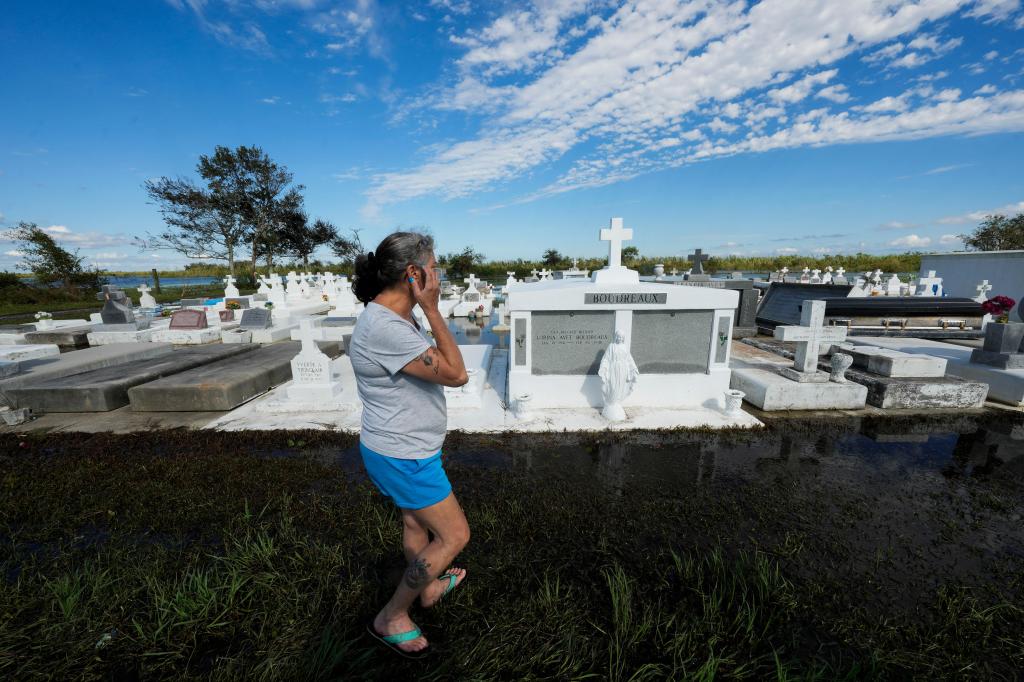DULAC, La. — Shortly after Hurricane Francine’s storm surge flooded a cemetery in the Louisiana bayou town of Dulac, Lori-Ann Bergeron arrived to check on three generations of family graves. Their tombstones were fine, but neighboring caskets had emerged beside broken crosses and soggy flower bouquets.
“It’s like this almost every time the water comes up, but this is the only place for them,” said Bergeron, 51, who on Thursday recalled her sister’s casket being unearthed when Hurricane Rita ravaged the area in 2005.
“That was rough, trying to bury somebody twice,” she said.
From cemeteries to homes to businesses and parks, Gulf Coast residents, many still reeling from the devastation of Hurricane Ida three years ago, were cleaning up the mess left by Francine, which struck Louisiana as a Category 2 hurricane Wednesday.
The storm knocked out power to hundreds of thousands of utility customers, sent a surge of water rushing into coastal communities and caused flash flooding.
“The human spirit is defined by its resiliency, and resiliency is what defines Louisiana,” Gov. Jeff Landry told a news conference. “Certainly there are times and situations that try us, but it is also when we in this state are at our very best.”
There were no reports of deaths or injuries, he said.
The storm, which drew fuel from exceedingly warm Gulf of Mexico waters, drenched a large swath of the South, including parts of Arkansas and Florida. Forecasters expected Francine to weaken Friday as it crosses northern Arkansas, but the storm’s slow progress will mean days of heavy rain in the Southeast, creating a flash flooding risk. Parts of Tennessee, Alabama and Georgia are at slight risk of excessive rainfall while northern and central Alabama face a moderate risk.
Heavy rain was forecast into the weekend in parts of the South and Southeast that could cause more flooding. Another 3 to 6 inches (8 to 15 centimeters), with about 8 inches (20 centimeters) in some locations, were expected in parts of central and northern Alabama through Sunday. In northeastern Mississippi, western Tennessee, western Georgia and the Florida Panhandle another 2 to 4 inches (5 to 10 centimeters) is expected.
Francine slammed into the Louisiana coast Wednesday evening with 100 mph (155 kph) winds in coastal Terrebonne Parish, battering a fragile coastal region that has not fully recovered from a series of devastating hurricanes in 2020 and 2021. The system then lashed New Orleans with torrential rain — leaving behind widespread power outages and debris-covered streets.
Rushing water nearly enveloped a pickup truck in a New Orleans underpass, trapping the driver inside. A 39-year-old emergency room nurse who lived nearby waded into the waist-high water with a hammer, smashed the window and pulled out the driver. The rescue was captured live by WDSU.
“It’s just second nature I guess, being a nurse, you just go in and get it done, right?” Miles Crawford told The Associated Press on Thursday. “I just had to get to get him out of there.”
The water was up to the driver’s head and rising, he said.
News footage from coastal communities showed waves from lakes, rivers and Gulf waters thrashing seawalls. Water poured into city streets in blinding downpours. Oak and cypress trees leaned in the high winds, and some utility poles swayed.
At the storm’s peak, 450,000 people in Louisiana were without power, according to the Public Service Commission. Many of the outages were linked to falling debris, not structural damage. At one point, around 500 people were in emergency shelters, officials said.
“The amount of money invested in resilience has really made a difference, from the power outages to the number of homes saved,” said Deanne Criswell, the Federal Emergency Management Agency administrator, who attended the governor’s news conference.
In the coastal community of Cocodrie in southern Louisiana, where many families own seasonal homes along the bayou for fishing, police guarded a road to prevent looting as people cleaned their properties.
Brooks Pellegrin, 50, and his family cleared muck out of their camp site, a two-story structure with a large dock on a canal about 14 miles (22 kilometers) from the Gulf of Mexico. They worked well into Thursday afternoon raking marsh grass and spraying down muddy floors after a 10-foot (3-meter) storm surge washed away the building’s back wall, porch and much of the boat deck.
“We built everything up so we wouldn’t have to do this. This one brought in a lot more water than Ida,” Pellegrin said. “It packed a lot more punch than I was expecting.”
For many in the area bordered by bayous, swamps, lakes and the Gulf of Mexico, threats of flooding and hurricanes have become a way of life, Lafourche Parish Sheriff Craig Webre said.
Water comprises about a quarter of the area in the parish, which is home to about 97,000 people south of New Orleans. In 2021, Ida made landfall in the southern point of the parish as a Category 4 hurricane with maximum sustained winds of 150 mph (241 kph).
That storm was “cataclysmic” and “the most significant hurricane” to impact the area. Following the 2021 storm, 90% of homes in the area needed a roof replacement and many houses were damaged beyond repair, Webre said.
Over the years, the area has become more resilient against storms, improving drainage and pumping stations and replacing roofs that can better withstand hurricane-force winds. Residents also are evacuating quicker when there are significant storm threats, Webre said.
“This population is very resilient. They’re very independent. They’re very pioneering,” he said.
Originally Published:
